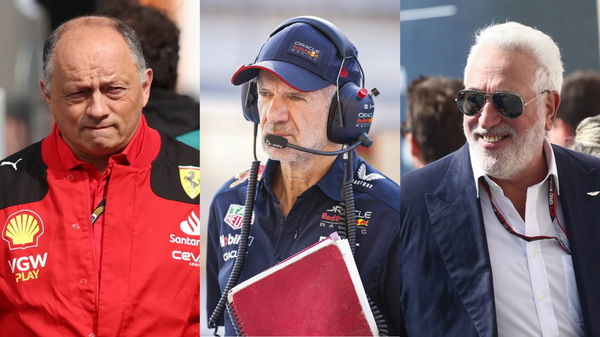Why Did F1 Stop Racing in Japan for 10 Years After the Ominous Fuji Speedway 1977 Grand Prix?

Follow Us

via Imago
October 9, 2022, Suzuka, Mie, Japan: October 8, 2022: Suzuka Circuit, Mie Prefecture, JAPAN: MAX VERSTAPPEN of Red Bull Racing 1 racing in heavy rain conditions as Max Verstappen wins the World Championship, WM, Weltmeisterschaft for Red Bull Racing at the Formula 1 Honda Japanese Grand Prix. Motorsports. Suzuka Japan – ZUMAb177 20221009_zap_b177_257 Copyright: xTaidghxBarronx
The Japanese GP that takes place at the unique ‘crossover’ Suzuka Circuit is like a festival in Japan. Since its introductory race in 1987, it is home to one of the most passionate F1 fans in the world. From handmade gifts to technologically and creatively advanced apparel, the Japanese fans have everything figured out.
Even though it is not one of the oldest classic tracks like Silverstone or Monza, when it comes to racing action, the high-speed circuit provides a marvelous spectacle for fans to witness. From Max Verstappen winning his 2nd World Championship here to Michael Schumacher losing his to Fernando Alonso, the history is heavenly. But this iconic track that has hosted many motorsport events, along with F1, wasn’t even F1’s first choice of venue.
F1’s inaugural 1976 Japanese GP and the Dangerous Fuji Speedway
ADVERTISEMENT
Article continues below this ad
The very first F1 race in Japan took place in 1976 at the Fuji Speedway. It took its name from Mount Fuji, in the foothills of which it is situated. Even back then, the interest that the local fans had in the sport was immense. Niki Lauda’s rivalry with James Hunt also marked the 1976 F1 championship. And it was this inaugural race at Fuji, the final round of F1 that year, that also decided the fate of the World Championship.

via Imago
1976 Japanese GP FUJI INTERNATIONAL SPEEDWAY, JAPAN – OCTOBER 24: James Hunt, McLaren M23 Ford during the Japanese GP at Fuji International Speedway on October 24, 1976 in Fuji International Speedway, Japan. PUBLICATIONxINxGERxSUIxAUTxHUNxONLY Copyright: xErcolexColombox 1017323182-COL-19761024-MCLAREN76025
Mario Andretti might have won the race, but James Hunt took all the headlines. The British racer, driving for McLaren, secured P3, and won the World Championship. He edged Niki Lauda by just 1 point to make his mark at the Pinnacle of Motorsport. Despite hosting a legendary battle, the circuit earned a bad name. And it was all because of the dangerous nature of the track and unpredictable downpours that made conditions treacherous.
Trending

Lando Norris Faces Brutal Injury After Party With Martin Garrix Goes Wrong Ahead of Miami GP
April 27, 2024 07:33 PM EDT

Miami GP Organisers Threaten to Revoke Donald Trump’s $250,000 Proposition for the Miami International Autodrome
April 27, 2024 04:47 PM EDT

Liam Lawson’s Surprise Contract Clause Threatens Daniel Ricciardo’s RB Seat
April 24, 2024 11:15 AM EDT

Adrian Newey’s “Personal Issue” With Christian Horner the Reason Behind Red Bull Mastermind’s Exit
April 27, 2024 10:51 AM EDT

F1 Rumor: Lawrence Stroll Offers Adrian Newey $100 Million to Poach Him From Frederic Vasseur and Co’s Interest
April 26, 2024 03:16 PM EDT
Get instantly notified of the hottest F1 stories via Google! Click on Follow Us and Tap the Blue Star.

Follow Us
F1’s 10-year absence from Japan after Gilles Villeneuve’s horrific crash at the 1977 Japanese GP
Mount Fuji, the stratovolcano, is an ominous indicator of what happened at the dangerous track in the 2 years when F1 raced here. The 1976 GP was a very controversial one. There was fog all around and certain sections of the track had running water. “My life is worth more than a title,” is what Niki Lauda said after making the decision to withdraw from the race in Lap 2 because of the life-threatening conditions.
After him, Larry Perkins, Carlos Pace, and Emerson Fittipaldi followed suit. As a result, Hunt won the World Championship controversially. Despite such conditions, fortunately, there were no major incidents. But the 1977 Japanese GP proved to be the final nail in the coffin for the Fuji Speedway.

via Imago
1977 Japanese GP FUJI INTERNATIONAL SPEEDWAY, JAPAN – OCTOBER 23: Gilles Villeneuve, Ferrari 312T2 spins onto the grass during the Japanese GP at Fuji International Speedway on October 23, 1977 in Fuji International Speedway, Japan. PUBLICATIONxINxGERxSUIxAUTxHUNxONLY 1017358872-LAT-19771023-77JAP27
The 1977 World Championship consisted of 17 races. However, Niki Lauda already sealed the championship and won the title by Race 15 at the United States Grand Prix. And owing to a deteriorating relationship with Ferrari, he didn’t even participate in the last 2 races. But what took center stage that year was the last round of racing in Japan.
Unlike 1976, Andretti crashed out in Lap 2 and couldn’t replicate his victory. But the chaos had just begun in spite of the weather being perfect, unlike the previous year. Later, Ronnie Peterson collided with Gilles Villeneuve. A crash that sent Villeneuve’s Ferrari into a group of spectators in a restricted area, killing a marshal and a photographer instantly. While the race continued despite this tragedy, F1 made the decision of never returning to the circuit. Thus, the 10-year absence, till Honda-built Suzuka Circuit brought the sport back to the country.
Toyota-owned Fuji Speedway loses out as the Honda-owned Suzuka Circuit hosts the Japanese GP
ADVERTISEMENT
Article continues below this ad
Honda began the ideation of the Suzuka Circuit in 1962. Soichiro Honda, the man behind the famous car brand, ambitiously decided to build a test track for the company. It was then that Dutchman John Hugenholtz built the iconic infinity-shaped crossover circuit. Immediately after the 1977 F1 season, there were rumored talks for the Japanese GP to turn to the Suzuka Circuit for 1978. But no concrete decision was taken, pushing the matter ahead.

via Imago
Motorsports: FIA Formula One World Championship, WM, Weltmeisterschaft 2019, Grand Prix of Japan, 5 Sebastian Vettel GER, Scuderia Ferrari Mission Winnow, Suzuka Japan
It was finally in 1987 when Formula 1 returned to Japan to race at Suzuka. And the rest is history. The S-shaped section, the 130R corner, and the high-speed nature provide an exhibition of racing for fans to marvel at. The track has witnessed many historic battles. For Japanese fans, 2022 was probably the best year to watch the race. Japan-based Honda, along with Max Verstappen, won the World Championship at the engine provider’s home race.
ADVERTISEMENT
Article continues below this ad
Watch This Story: How is Aston Martin Allying with Honda for its F1 Title Challenge from 2026?
The Suzuka Circuit might have come quite late to host the F1 scene, but it is here to stay. The passion that the country’s crowd has is unbelievable, and the atmosphere created translates into nail-biting races.
Edited by:
Akash Pandhare

